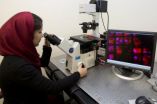(Press-News.org) WASHINGTON, March 3, 2014 — Pepper is one of the most plentiful condiments in the world today, but it used to be more valuable than gold. In the American Chemical Society's (ACS') latest Reactions video, we examine how pepper's delectable chemistry made it a key player in the global spice trade. The sought-after spice helped usher in the "Age of Discovery," which bridged the gap between the Middle Ages and the Modern era. And because we're celebrating our second month of existence, it's a Reactions double feature this week. In our second video, we examine the science behind the most misunderstood spice in the world: allspice. The videos are available at the links below:
The chemistry of pepper, the spice that changed the world: http://youtu.be/CKrrks2MugU
Allspice: The world's most misunderstood spice: http://youtu.be/powCDlagwik
INFORMATION:
Subscribe to the series at Reactions YouTube, and follow us on Twitter @ACSreactions to be the first to see our latest videos.
The American Chemical Society is a nonprofit organization chartered by the U.S. Congress. With more than 161,000 members, ACS is the world's largest scientific society and a global leader in providing access to chemistry-related research through its multiple databases, peer-reviewed journals and scientific conferences. Its main offices are in Washington, D.C., and Columbus, Ohio.
To automatically receive news releases from the American Chemical Society, contact newsroom@acs.org.
Follow us: Twitter Facebook
The chemistry (and fascinating history) of pepper, the spice that changed the world
2014-03-04
ELSE PRESS RELEASES FROM THIS DATE:
Team models photosynthesis and finds room for improvement
2014-03-04
CHAMPAIGN, Ill. — Teaching crop plants to concentrate carbon dioxide in their leaves could increase photosynthetic efficiency by 60 percent and yields by as much as 40 percent, researchers report in a new study.
The team used a computer model to simulate how adding genes from a type of photosynthetic algae known as cyanobacteria might influence photosynthetic efficiency in plants. Cyanobacteria contain small structures, called carboxysomes, which concentrate carbon dioxide at the site of photosynthesis.
"Photosynthesis is the most studied of all plant processes, so ...
Scientists identify protein linked to most common movement disorder
2014-03-04
Quebec City, March 3rd, 2014—A team of researchers from Université Laval and CHU de Québec identified unusually high levels of a certain protein in the brains of people suffering from essential tremor (ET), a movement disorder that affects 4% of the adult population. The discovery, the details of which were published in the most recent edition of the journal Movement Disorders, could lead to an effective treatment for this neurological condition, which is 10 times more prevalent than Parkinson's disease.
As its name suggests, ET causes tremors in various parts of the ...
UC research tests range of electrical frequencies that help heal chronic wounds
2014-03-04
Naturally occurring electricity in our cells is key to how our bodies function, and that includes the healing of wounds.
And externally applied low-amplitude electric fields have been shown to help hard-to-heal chronic wounds, like those associated with diabetes, where there is insufficient blood supply and drug treatments are not effective. The externally applied electric field manipulates the body's naturally occurring electricity, such that the new vessels are formed, and blood supply to the wound is increased.
University of Cincinnati physics and biomedical engineering ...
Cigarette smoking may cause physical changes in brains of young smokers, UCLA study shows
2014-03-04
The young, it turns out, smoke more than any other age group in America. Unfortunately, the period of life ranging from late adolescence to early adulthood is also a time when the brain is still developing.
Now, a small study from UCLA suggests a disturbing effect: Young adult smokers may experience changes in the structures of their brains due to cigarette smoking, dependence and craving. Even worse, these changes can occur in those who have been smoking for relatively short time. Finally, the study suggests that neurobiological changes that may result from smoking ...
Pitt public health analysis provides guidance on hospital community benefit programs
2014-03-04
PITTSBURGH, March 3, 2014 – A new analysis led by the University of Pittsburgh Graduate School of Public Health offers insights for nonprofit hospitals in implementing community health improvement programs.
In a special issue of the Journal of Health Care for the Poor and Underserved that focuses on the Affordable Care Act (ACA), a multidisciplinary team of Pitt researchers explore published research on existing community benefit programs at U.S. hospitals and explain how rigorous implementation of such programs could help hospitals both meet federal requirements and ...
New study reveals insights on plate tectonics, the forces behind earthquakes, volcanoes
2014-03-04
The Earth's outer layer is made up of a series of moving, interacting plates whose motion at the surface generates earthquakes, creates volcanoes and builds mountains. Geoscientists have long sought to understand the plates' fundamental properties and the mechanisms that cause them to move and drift, and the questions have become the subjects of lively debate.
A study published online Feb. 27 by the journal Science is a significant step toward answering those questions.
Researchers led by Caroline Beghein, assistant professor of earth, planetary and space sciences ...
Novel drug treatment protects primates from deadly Marburg virus
2014-03-04
For the first time, scientists have demonstrated the effectiveness of a small-molecule drug in protecting nonhuman primates from the lethal Marburg virus. Their work, published online in the journal Nature, is the result of a continuing collaboration between Army scientists and industry partners that also shows promise for treating a broad range of other viral diseases.
According to senior author Sina Bavari, the drug, known as BCX4430, protected cynomolgous macaques from Marburg virus infection when administered by injection as long as 48 hours post-infection. Bavari ...
Manufacturing a solution to planet-clogging plastics
2014-03-04
Researchers at Harvard's Wyss Institute have developed a method to carry out large-scale manufacturing of everyday objects – from cell phones to food containers and toys – using a fully degradable bioplastic isolated from shrimp shells. The objects exhibit many of the same properties as those created with synthetic plastics, but without the environmental threat. It also trumps most bioplastics on the market today in posing absolutely no threat to trees or competition with the food supply. The advance was reported online last week in Macromolecular Materials & Engineering. ...
Pediatric surgeons develop standards for children's surgical care in the United States
2014-03-04
Chicago (March 3, 2014): The American College of Surgeons (ACS) has published new comprehensive guidelines that define the resources the nation's surgical facilities need to perform operations effectively and safely in infants and children. The standards—published in the March issue of the Journal of the American College of Surgeons—also have the approval of the American Pediatric Surgical Association and the Society of Pediatric Anesthesia. Representatives of these organizations as well as invited leaders in other pediatric medical specialties, known as the Task Force ...
HPV vaccine provides significant protection against cervical abnormalities
2014-03-04
The HPV vaccine offers significant protection against cervical abnormalities in young women, suggests a paper published on bmj.com today.
The human papillomavirus (HPV) can cause warts, with some strains causing cervical cancer.
Australia was the first country to implement a publicly funded national vaccination programme in April 2007 and a 'catch-up' programme that ran until December 2009.
Studies have shown that the two HPV vaccines used to vaccinate young women prevent cervical lesions associated with HPV types including vulval and vaginal lesions and genital ...



